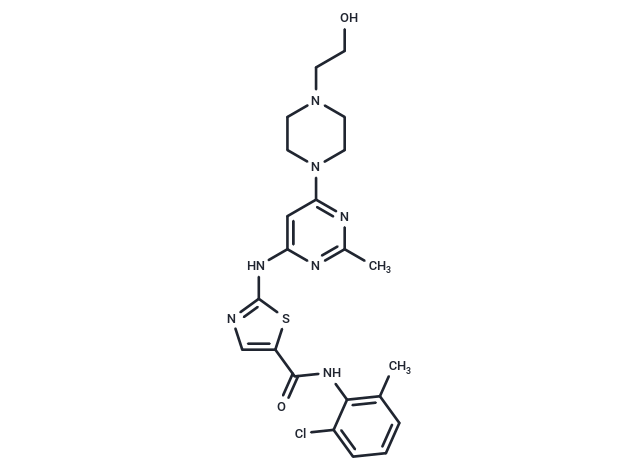 您的购物车当前为空
您的购物车当前为空
Dasatinib
一键复制产品信息别名 达沙替尼, BMS-354825
Dasatinib (BMS-354825) 是一种酪氨酸激酶抑制剂,抑制 Src 和 Bcr-Abl (Ki=16/30 pM),具有口服活性和 ATP 竞争性。Dasatinib 具有抗肿瘤活性,用于治疗白血病和淋巴瘤等。

Dasatinib
一键复制产品信息Dasatinib (BMS-354825) 是一种酪氨酸激酶抑制剂,抑制 Src 和 Bcr-Abl (Ki=16/30 pM),具有口服活性和 ATP 竞争性。Dasatinib 具有抗肿瘤活性,用于治疗白血病和淋巴瘤等。
| 规格 | 价格 | 库存 | 数量 |
|---|---|---|---|
| 5 mg | ¥ 153 | 现货 | |
| 10 mg | ¥ 198 | 现货 | |
| 25 mg | ¥ 318 | 现货 | |
| 50 mg | ¥ 453 | 现货 | |
| 100 mg | ¥ 656 | 现货 | |
| 200 mg | ¥ 958 | 现货 | |
| 500 mg | ¥ 1,580 | 现货 | |
| 1 mL x 10 mM (in DMSO) | ¥ 152 | 现货 |
产品介绍
| 产品描述 | Dasatinib (BMS-354825) is a tyrosine kinase inhibitor that inhibits Src and Bcr-Abl (Ki=16/30 pM) and is orally active and ATP-competitive. Dasatinib has antitumor activity and is used in the treatment of leukemia and lymphoma. |
| 靶点活性 | p38:100 nM, PDGFRβ:28 nM, yes:0.5 nM, Her2:710 nM, FGFR1:880 nM, MEK:1700 nM, Abl:0.6 nM (cell free), Her1:180 nM, c-Kit (D816V):37 nM (cell free), lck:0.4 nM, c-Kit (WT):79 nM (cell free), Src:0.8 nM (cell free), p210 (BCR-ABL):1.0 nM |
| 体外活性 | 方法:8 种甲状腺癌细胞用 Dasatinib (0.019-1.25 μmol/L) 处理 3 天,使用 SRB 方法检测细胞增殖。 |
| 体内活性 | 方法:为检测体内抗肿瘤活性,将 Dasatinib (50 mg/kg in 80 mmol/L sodium citrate buffer, pH 3.0) 口服给药给携带人甲状腺癌肿瘤 BCPAP 或 8505C 的 athymic nude 小鼠,每周五天,持续二十天。 |
| 激酶实验 | Kinase assays using wild-type and mutant glutathione S-transferase (GST)–Abl fusion proteins (c-Abl amino acids 220-498) were done as described, with minor alterations. GST-Abl fusion proteins were released from glutathione-Sepharose beads before use; the concentration of ATP was 5 μmol/L. Immediately before use in kinase autophosphorylation and in vitro peptide substrate phosphorylation assays, GST-Abl kinase domain fusion proteins were treated with LAR tyrosine phosphatase according to the manufacturer's instructions. After 1-hour incubation at 30°C, LAR phosphatase was inactivated by addition of sodium vanadate (1 mmol/L). Immunoblot analysis comparing untreated GST-Abl kinase to dephosphorylated GST-Abl kinase was routinely done using phosphotyrosine-specific antibody 4G10 to confirm complete (>95%) dephosphorylation of tyrosine residues and c-Abl antibody CST 2862 to confirm equal loading of GST-Abl kinase. The inhibitor concentration ranges for IC50 determinations were 0 to 5,000 nmol/L (imatinib and AMN107) or 0 to 32 nmol/L (BMS-354825). The BMS-354825 concentration range was extended to 1,000 nmol/L for mutant T315I. These same inhibitor concentrations were used for the in vitro peptide substrate phosphorylation assays. The three inhibitors were tested over these same concentration ranges against GST-Src kinase and GST-Lyn kinase [1]. |
| 细胞实验 | Ba/F3 cell lines were plated in triplicate and incubated with escalating concentrations of imatinib, AMN107, or BMS-354825 for 72 hours. Proliferation was measured using a methanethiosulfonate-based viability assay. IC50 and IC90 values are reported as the mean of three independent experiments done in quadruplicate. The inhibitor concentration ranges for IC50 and IC90 determinations were 0 to 2,000 nmol/L (imatinib and AMN107) or 0 to 32 nmol/L (BMS-354825). The imatinib concentration range was extended to 6,400 nmol/L for mutants with IC50 >2,000 nmol/L. The BMS-354825 concentration range was extended to 200 nmol/L for mutant T315I [1]. |
| 动物实验 | For in vivo studies, dasatinib (50 mg/kg) was prepared for daily oral gavage (5 d/wk) in 80 mmol/L sodium citrate buffer, pH 3.0. For the orthotopic murine model, mice were randomized on day 10 based on bioluminescence activity to receive drug or vehicle. In the metastatic murine model, mice received dasatinib or vehicle, as described earlier, starting 2 days before intracardiac injection (pretreatment), or on day 11 following randomization (posttreatment) [4]. |
| 别名 | 达沙替尼, BMS-354825 |
| 分子量 | 488.01 |
| 分子式 | C22H26ClN7O2S |
| CAS No. | 302962-49-8 |
| Smiles | N(C1=CC(N2CCN(CCO)CC2)=NC(C)=N1)C=3SC(C(NC4=C(C)C=CC=C4Cl)=O)=CN3 |
| 密度 | 1.408g/cm3 |
| 存储 | store at low temperature,keep away from moisture | Powder: -20°C for 3 years | In solvent: -80°C for 1 year | Shipping with blue ice/Shipping at ambient temperature. | |||||||||||||||||||||||||||||||||||
| 溶解度信息 | H2O: < 1 mg/mL (insoluble or slightly soluble) Ethanol: < 1 mg/mL (insoluble or slightly soluble) DMSO: 262.5 mg/mL (537.9 mM), Sonication is recommended. | |||||||||||||||||||||||||||||||||||
| 体内实验配方 | 10% DMSO+40% PEG300+5% Tween 80+45% Saline: 9.1 mg/mL (18.65 mM), Suspension. 请按顺序添加溶剂,在添加下一种溶剂之前,尽可能使溶液澄清。如有必要,可通过加热、超声、涡旋处理进行溶解。工作液建议现配现用。以上配方仅供参考,体内配方并不是绝对的,请根据不同情况进行调整。 | |||||||||||||||||||||||||||||||||||
溶液配制表 | ||||||||||||||||||||||||||||||||||||
DMSO
| ||||||||||||||||||||||||||||||||||||
计算器
体内实验配液计算器
以上为“体内实验配液计算器”的使用方法举例,并不是具体某个化合物的推荐配制方式,请根据您的实验动物和给药方式选择适当的溶解方案。
剂量转换
对于不同动物的给药剂量换算,您也可以参考 更多




 很棒
很棒
 |
|